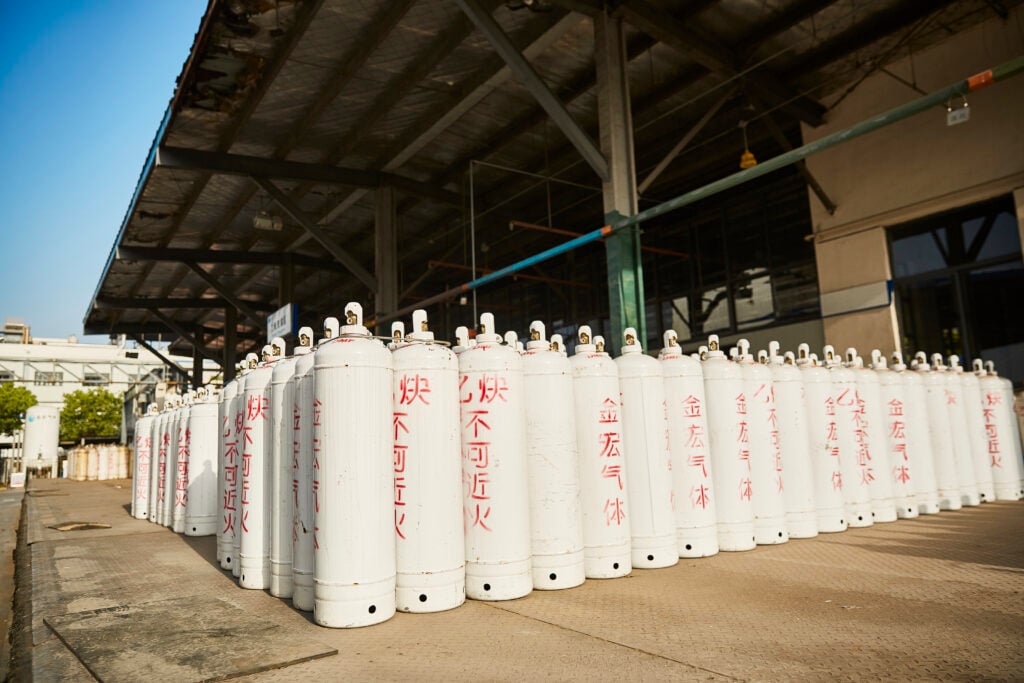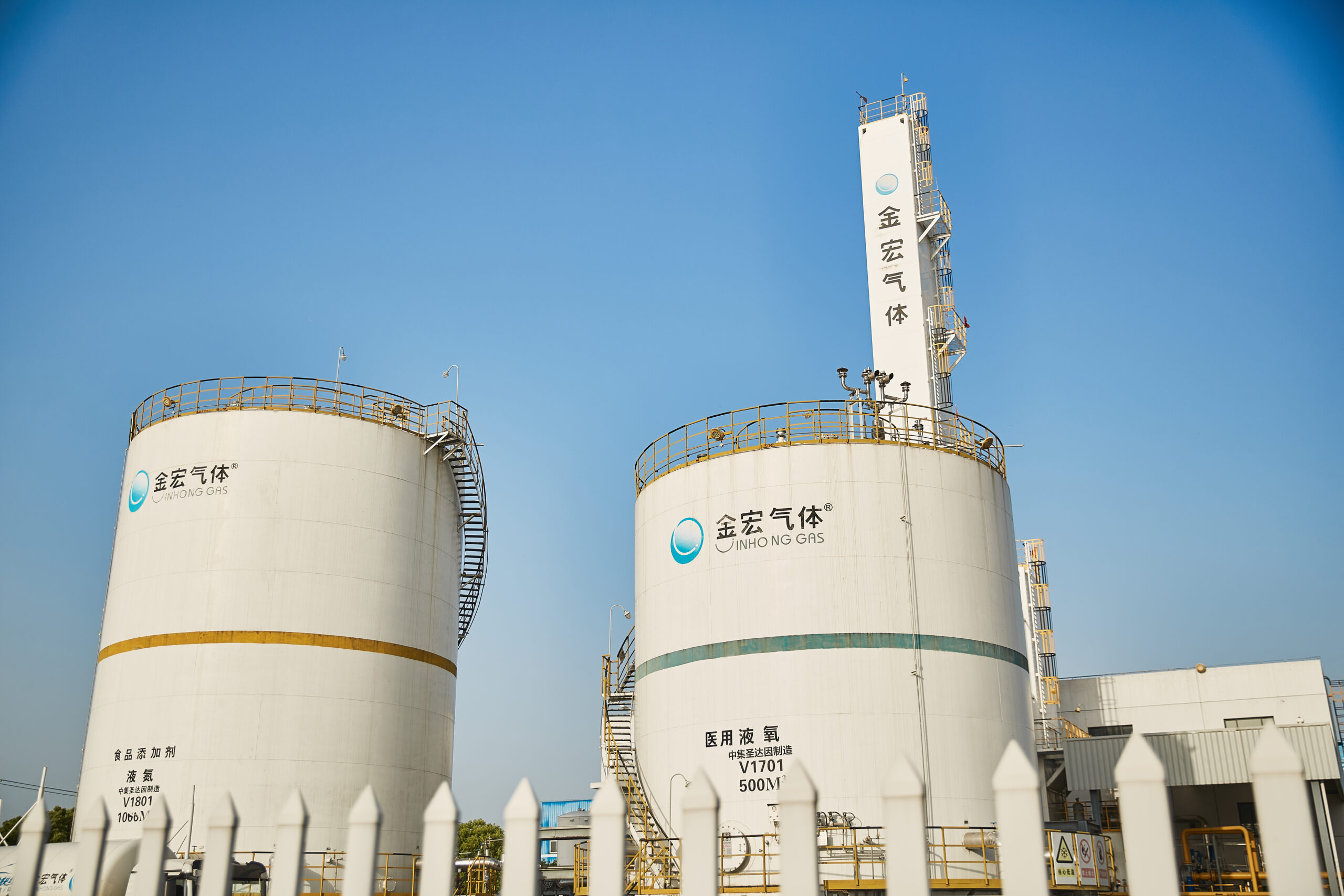Safe Use and Transportation of Oxygen Cylinders
Transportation
- Before transporting, ensure the safety cap is tightly secured and a protective collar is in place.
- Handle cylinders with care—load and unload gently to prevent impact or damage.
- Rolling cylinders on the ground or dropping them from heights is strictly prohibited.
- Do not transport oxygen cylinders in the same vehicle with flammable materials, grease, or oil-contaminated items.
Storage
- Store oxygen cylinders away from direct sunlight, high temperatures, open flames, and metal sparks.
- Do not store flammable materials within 10 meters of oxygen cylinders.
- Always store cylinders in an upright position with the cap screwed on tightly to prevent dust or grease from entering the valve. Cylinders should be secured with railings or brackets to prevent tipping.
- Maintain a distance of at least 1 meter from heaters or other heat sources.
Usage
- Before attaching a pressure regulator, slowly open the cylinder valve to purge dust from the interface, then attach the regulator and open the valve again to check for leaks.
- Always stand to the side of the cylinder valve when operating it—never face it directly.
- Check that hoses and fittings are free of dust or metal shavings before connecting.
- After use, do not place hoses upright or on the ground to prevent contamination.
- Never completely empty the oxygen cylinder; retain 1–1.5 atmospheres of pressure to facilitate future leak testing and prevent contamination.
- In winter, thaw frozen valves only with warm water or steam—never use open flames or strike with metal tools.
- When working in proximity to electric welding, place an insulating mat under the cylinder to avoid electrical conductivity.
- All metal pipes and equipment in contact with the cylinder should be properly grounded to prevent static discharge that could cause fires or explosions.
| Category | Oxygen Cylinder | Acetylene Cylinder |
|---|---|---|
| Storage Position | Upright only, secured with cap and bracket | Upright only, never laid down |
| Distance from Heat | >1 meter from heat sources | >1 meter from heat sources |
| Direct Sunlight | Must be avoided | Must be avoided |
| Flammable Material | ≥10 meters away from flammable substances | ≥10 meters away from flammable substances |
| Transport | With protective cap and ring, gently handled | With shock-absorbing ring, gently handled |
| Usage Temperature | Max 40°C | Max 40°C |
| Valve Thawing | Warm water or steam only | Warm water or steam only |
| Residual Pressure | ≥ 0.1 MPa (0.098–0.196 MPa) | Winter: 49–98 kPa; Summer: ~196 kPa |
| Avoid Oil Contact | Strictly prohibited | Required for safety due to explosive compounds |
Why Acetylene Cylinders Must Be Stored and Used Upright
Reason 1: Preventing Acetone Leakage
Acetylene cylinders are filled with a porous material and acetone solvent. If used in a horizontal position, acetone can flow out with the acetylene gas. This increases acetone consumption, lowers the combustion temperature, and may cause flashbacks—posing an explosion risk.
Inside the cylinder, acetylene is dissolved in acetone under pressure. When the valve is opened and pressure drops, acetylene gas is released. If the cylinder is lying down, acetone can leak and rapidly evaporate, forming an explosive mixture with air.
- Explosion range: 2.3%–72.3% (volume)
- Minimum ignition energy: 0.019 mJ
Even a minor heat source or flame could cause an explosion. Additionally, internal pressure may force both acetone and acetylene out, causing rapid pressure buildup and increasing the risk of explosion.
Reason 2: Cylinder Instability
A horizontally placed acetylene cylinder may roll. If it collides with other objects or cylinders, the impact may generate energy and trigger an explosion.
Reason 3: Static Electricity Risks
Acetylene cylinders are equipped with anti-vibration rubber rings that also act as insulators. When placed horizontally, the entire cylinder rests on an insulating surface, preventing static from grounding. Accumulated static electricity may spark and ignite leaked acetylene, leading to fire or explosion.
Reason 4: Equipment Damage
Acetylene valves are typically connected to pressure regulators, flashback arrestors, and hoses. Laying the cylinder horizontally increases the risk of rolling, which can damage or disconnect these components and cause gas leaks.
Conclusion: Acetylene cylinders must always be stored and used in an upright position.

15 Safety FAQs for Welding Gas Cylinders
1. Why must cylinders be protected from tipping?
If a cylinder tips over, the valve could be damaged, causing gas to escape rapidly. The resulting reaction force may propel the cylinder, potentially injuring people or causing damage. For flammable gases, this could trigger explosions.
2. Why must oxygen and acetylene cylinders be stored separately?
Acetylene is flammable, and oxygen supports combustion. If acetylene leaks and ignites, the resulting explosion could rupture nearby oxygen cylinders, intensifying the blast uncontrollably. Therefore, they must never be stored together.
3. Why must cylinders not be exposed to direct sunlight?
Acetylene cylinders should not exceed 40°C. Acetone’s boiling point is 58°C. Higher temperatures increase acetone evaporation, releasing more acetylene and drastically raising internal pressure.
4. Why must residual pressure be retained in cylinders?
Leaving a few kilograms of residual pressure ensures internal pressure remains higher than external pressure, preventing air from entering and reducing explosion risk.
- Oxygen cylinders: ≥ 0.098–0.196 MPa
- Acetylene cylinders:
- Winter: 49–98 kPa
- Summer: ~196 kPa
5. Why must oxygen cylinders never come into contact with grease?
Grease—especially unsaturated or fatty acids—can oxidize rapidly in oxygen, generating heat and self-igniting. When high-pressure oxygen is released, it may oxidize grease at the valve outlet, generating heat and causing ignition or even explosion.
6. Why are cylinder caps essential?
Cylinder valves are made of copper alloy or steel and are structurally weaker than the bottle. Any impact can break the valve, releasing high-pressure gas and turning the cylinder into a projectile. For acetylene, this could also release flammable gas, increasing explosion risk. Caps protect against mechanical damage and prevent grease or dust contamination.
7. Why must acetylene cylinders not be bumped?
Impacts can fracture the porous material inside, increasing the space for acetylene gas, raising pressure, and creating explosion risks. Elevated temperature can also lead to acetylene polymerization and explosion.
8. Why must gas cylinders be handled gently?
Severe impact or rough handling may cause structural damage and explosion, with potentially severe consequences.
9. Why should oxygen cylinders not be lifted by hoisting?
They are high-pressure vessels—dropping them could cause explosions. For bulk transport, specialized racks should be used for lifting and unloading.
10. Why do acetylene cylinders explode?
Explosion is mainly due to sudden increases in temperature or pressure, causing acetylene decomposition. Warning signs include heat radiating from the cylinder head or strange-smelling smoke escaping from the valve.
Triggers:
- Flashback from welding
- External heat sources
- Fire near the valve or regulator
- Severe impact or vibration
Prevention:
- Use flashback arrestors
- Avoid direct sunlight and heat
- Never hang torches on the cylinder
- Handle gently during transport
11. Why can’t oxygen and acetylene hoses be interchanged?
Oxygen hoses are high-pressure rated, while acetylene hoses are low-pressure. Acetylene hoses may accumulate carbon from minor flashbacks. If reused for oxygen, these residues could ignite and cause explosions.
12. Why can’t cylinders be mixed or used interchangeably?
Filling a cylinder with an incompatible gas may cause violent reactions and explosions.
13. Why insulate oxygen cylinders when used near electric welding?
To prevent them from becoming electrically charged. Insulating the base and grounding connected metal equipment avoids static buildup and reduces fire/explosion risks.
14. Why shouldn’t acetylene cylinders be placed on insulators?
The ignition energy for acetylene is only 0.019 mJ—static discharge is enough to ignite it. Grounding the cylinder dissipates static, preventing accidental explosions.
15. Why must copper alloy tools used with acetylene contain less than 70% copper?
Prolonged contact between acetylene and copper or silver forms explosive compounds like copper acetylide. These are sensitive to heat (110–120°C) and shock and can explode violently.

Fire Safety Management for Oxygen Cylinders
Oxygen cylinders must comply with strict fire safety protocols to avoid fire and explosion hazards. Key precautions include:
- Placement: Store in a cool, dry, well-ventilated area, at least 10 meters from heat or flame.
- Sunlight and Tipping: Shield from direct sunlight. Secure cylinders to prevent tipping and ensure stability.
- Valve Protection: Keep valves and regulators clean and grease-free. Avoid using greasy tools near oxygen equipment.
- Shock Protection: Use anti-vibration rings to prevent damage during handling.
- Residual Pressure: Always retain ≥0.1 MPa residual pressure to prevent air backflow.
- Routine Inspection: Regularly check the cylinder body, valves, and accessories for integrity and completeness.
Following these precautions significantly reduces fire and explosion risks during oxygen cylinder use and storage.
Operating Procedure for Emptying Oxygen Cylinders
Emptying an oxygen cylinder must be done according to strict procedures to ensure safety. Follow these steps:
Preparation
- Ensure the cylinder is cool—never vent a hot cylinder.
- Check that the valve is intact and leak-free.
- Prepare explosion-proof tools, gloves, safety goggles, etc.
Procedure
- Place the cylinder upright on a flat, stable surface to prevent tipping.
- Close the outlet valve to avoid uncontrolled leaks.
- If available, connect to a designated venting device or exhaust system to safely discharge the gas into the atmosphere.
- Monitor the pressure gauge throughout the venting process until the cylinder is fully depressurized.
- Once empty, close the venting device and double-check that the main valve is completely shut.
Post-venting Handling
- Label the cylinder clearly as “Empty” for prompt replacement.
- Clean and inspect the cylinder for damage or residue.
- If stored long-term, conduct regular safety inspections to ensure continued safe performance.



